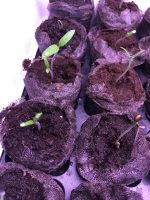A Pendulum of Hope and Worry: The Tale of a Bee Colony
Amazing how long a human being can be in a state of hopeful denial.
On Friday, Sept. 13, my bee colony met death and death won.
I debated long and hard whether or not to write this post. So often, in social media, we share highlights and successes. In this blog about city homesteading, I acknowledged that I was not an expert and still have a lot to learn. But did I really want to share about a failure? After writing a post on how I was trying to be a bee guardian and why I thought that a top bar hive was a good way of providing a more natural habitat for bees, did I want to admit that my bees died? Would that mean that I wasn’t a good bee caretaker? Would that cast top bars in a negative light? But, in the end, because both success and failure are learning opportunities, I decided that I would write the story of my bees.
I got my bees at the end of July 2012. They were delivered, along with my hive, from Wisconsin. It was an established small colony with about nine or 10 bars of comb already started. That fall, the bees were busy, gathering and storing honey. I worried about them because I had gotten them so late in the season. Would they be able to store enough honey for the winter? Would there be enough bees so that they could adequately huddle over the winter months and survive the cold?
Winter came and I continued worrying. But bees are used to seasons. I just hoped my colony was strong enough to survive. In late winter, on warm days, I was happy to see bees emerging. When spring came, the bees went off on foraging flights and came back laden with pollen, even though I couldn’t see any flowers blooming yet. I was happy. They were going to make it! I added a few empty bars to the back of the hive to give the colony room to expand and began feeding them some sugar water.
Spring is a tricky time for bees. The weather starts getting warmer and the bees begin leaving the hive to forage for nectar and pollen. But temperatures can fluctuate and a late cold snap might catch bees unprepared. The bees might not be able to cluster together to keep eggs and larvae warm. I watched the activity in and out of the hive anxiously and was relieved when it seemed that the bees were doing what bees are supposed to do.
At the end of June, I started worrying that something was wrong. The bees had started making some new comb in May, but then the work stalled out. Furthermore, it looked like there were significantly fewer bees in the hive. I followed a suggestion to add an empty bar between bars with brood comb (combs that have eggs and larvae) to try to instigate their need to build comb. I was confident that this would work and my bees would continue building up the hive.
A month passed and the bees still hadn’t built any new comb. I was confused. I didn’t know what they were doing. I was seeing many more male drone bees and not as many female worker bees. Furthermore, though there were plenty of flowering plants nearby, the workers were not bringing pollen back to the hive. I started asking some questions on an online forum and was told that I might not have a laying queen bee. Once I had a fertile queen, the workers should start collecting pollen again.
Clearly, it was time to do a more thorough inspection of the hive. I opened up the hive in late July and saw some hopeful signs. It looked like there were some queen cells and, while one of them was closed, a couple of others looked open. Perhaps a queen had hatched. Also, there were more bees inside the hive than I had expected, especially toward the entrance, where an active queen would normally be laying eggs. The bees near the entrance became quite agitated when I was pulling bars off to inspect. I was sure they were protecting a new queen. With renewed hope, I put everything back and covered up the hive.
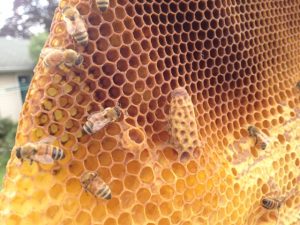 I now had formulated a scenario of what had happened: my bees had swarmed sometime in June, which accounted for the fewer number of bees we were seeing; something had happened to the queen that was left in the hive and the workers had to make another queen – hence the queen cells; a new queen was being made; bees know what they are doing; everything was going to be fine.
I now had formulated a scenario of what had happened: my bees had swarmed sometime in June, which accounted for the fewer number of bees we were seeing; something had happened to the queen that was left in the hive and the workers had to make another queen – hence the queen cells; a new queen was being made; bees know what they are doing; everything was going to be fine.
After a couple of weeks I finally saw some bees bringing back pollen. Even though the population still seemed pretty small, this activity was a very hopeful sign.
Hope turned to dismay at the beginning of September when the population suddenly spiraled downward. I saw hardly any bees outside the hive. Upon opening up the hive for another inspection, I saw dead bees on the floor of the hive, yellow jackets inside probably feasting on honey. There were more bees inside than I had expected to see. That was a good sign. I decided to reduce the size of the hive so that the remaining bees had a smaller territory to defend from the yellow jackets, so I pulled off some of the bars that had comb and honey and closed off two of the entrance holes. I also saw little white worms that I hoped were bee larvae but that I suspected were larvae from pests, either small hive beetle or wax moth.
It was time to bring in an expert. Andy Ammons from Goshen College was going to come on Friday to help me figure out what was going on.
On Friday, I came home from work and saw what I interpreted as a miracle. Bees, many bees, many many bees, all clustering around the entrance of my hive. Hope surged. Even though I knew it wasn’t really the right season for it, I assumed a swarm had found my nearly empty hive and was going to take up residence. Little did I know what really was going on.
Andy clued me in when he arrived. It was not a benevolent swarm. Rather, bees from other colonies, maybe many other colonies, had discovered my weak, failing colony and had come to rob the honey.
The activity of robber bees is amazing to see. It is a frenzy of action as the bees focus on one thing and one thing only – get honey. They pay no attention to anything other than to eat through wax and get to the honey that is stored in the comb. The few remaining guard bees of the original colony stood no chance against the invasion. We saw some fighting, invaders attacking the guard bees and overwhelming them. We saw drone bees, from my colony, begging invaders to feed them honey and invaders oblige. We witnessed the end of my colony, but it was still a pretty impressive sight.
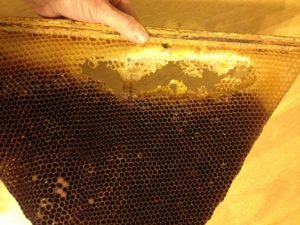 That night, we salvaged what remained of the ravaged comb. There was a tiny bit of honey in some of the cells, but the robbers had been very thorough. Fortunately, for us, we will be able to harvest some honey from the bars we pulled off from our last inspection.
That night, we salvaged what remained of the ravaged comb. There was a tiny bit of honey in some of the cells, but the robbers had been very thorough. Fortunately, for us, we will be able to harvest some honey from the bars we pulled off from our last inspection.
In this tale of the bee colony, I alternated between hope and worry. I clung to all those little signs that seemed to indicate that things were going to be all right. After it was all over for my colony, I posted in our family Facebook group: Amazing how long a human being can be in a state of hopeful denial. My sister in law replied: That spirit has changed history. Not all bad.
There is always next year.
A World That Needs ‘Bee Guardians’
A homestead needs farm animals. That can be a bit of a problem for a city homestead. One can have dogs or cats, but, here in my city, there are rules and there are ordinances.That means, much as I would like to have my own fresh eggs, I can’t keep chickens. Ever since I went hiking with a friend and his goats, I have wanted to have a couple of goats. With goats, I could try making cheese. And if they were Angora goats, I would also have wonderful mohair fiber to spin. But, alas, I can’t have goats. So what is a city homesteader to do? My answer: honey bees!
This summer I got a beehive and a colony of honey bees. I had been thinking of getting bees for a couple of years, but somehow just didn’t get around to getting set up. In June I went to the Midwest Renewable Energy Fair and fell in love with the design of a top bar beehive.
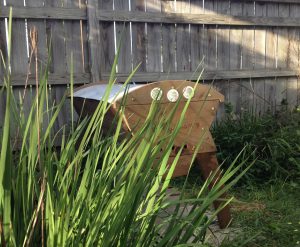 With a top bar beehive, the bees build comb downwards from the bar in shapes of (mostly) their own choosing (they are, after all, constrained by the sides, top and bottom of the hive box). Though each of the cells is the usual hexagon, the sizes of individual cells varies and the combs themselves are wonderfully shaped in organic undulations. I’ve seen how these comb shapes get started, with bee hanging onto bee, like trapeze artists, to form what I assume to be a catenary shape. My top bar hive has windows on either side so that I can see the hundreds of bees that live inside doing all manner of bee tasks.
With a top bar beehive, the bees build comb downwards from the bar in shapes of (mostly) their own choosing (they are, after all, constrained by the sides, top and bottom of the hive box). Though each of the cells is the usual hexagon, the sizes of individual cells varies and the combs themselves are wonderfully shaped in organic undulations. I’ve seen how these comb shapes get started, with bee hanging onto bee, like trapeze artists, to form what I assume to be a catenary shape. My top bar hive has windows on either side so that I can see the hundreds of bees that live inside doing all manner of bee tasks.
As fall approaches, during the warmer, sunnier days, my bees are working away, storing up honey for the winter. I worry about them. Will they have enough honey to feed themselves for the entire winter? Now evening temperatures are dropping and I am seeing less and less activity. They huddle together inside the hive. Is it too cold for them? Will they survive? What should I plant next spring that they will like to feed on? Are they happy? It is remarkable how attached I am getting to my little colony of bees. I want them to live and thrive.
Now that I have bees, I am more and more aware of how many other people in Goshen also have bees. Some are longtime beekeepers; others have just started tending to bees in the last couple of years. I am glad to see that. Honey bees are remarkable creatures. They work for the good of the entire colony. They pollinate our flowers and our crops. They create that wonderful nectar we call honey.
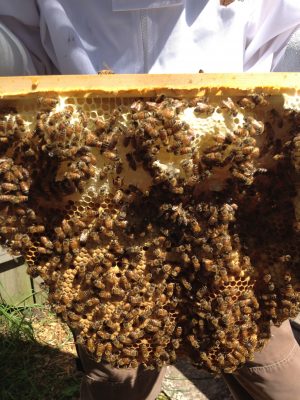 So I suppose I am now a beekeeper. But I really don’t like that name. Because, really, I am not “keeping” the bees. True, I did get them from somewhere, so I did impose my will on them, uprooting the colony from wherever it had initially made its home. But now, what I want, is not to keep them, but to tend them, to give them an appropriate habitat, to provide them with forage they need, to make sure their hive is secure.
So I suppose I am now a beekeeper. But I really don’t like that name. Because, really, I am not “keeping” the bees. True, I did get them from somewhere, so I did impose my will on them, uprooting the colony from wherever it had initially made its home. But now, what I want, is not to keep them, but to tend them, to give them an appropriate habitat, to provide them with forage they need, to make sure their hive is secure.
Some people call themselves “bee guardians.” I like that. I will care for my bees. In the spring, should there be some honey that is left over from overwintering, I may take some, and the cycle of the colony’s life will start all over again.
In an article published in the September/October 2005 issue Orion Magazine, Wendell Berry talks about “Renewing Husbandry.” The term “husbandry” bothers me a bit, since it isn’t gender inclusive, but I do like what Berry has to say about husbandry in general and animal husbandry in particular (and, in this, I am including insects — and, in particular, bees).
“To husband is to use with care, to keep, to save, to make last, to conserve.
…
Without husbandry, ‘soil science’ too easily ignores the community of creatures that live in and from, that make and are made by, the soil. Similarly, ‘animal science’ without husbandry forgets, almost as a requirement, the sympathy by which we recognize ourselves as fellow creatures of the animals.”
Bees are now in danger. Colonies are dying. I think that may be due to increased use of pesticides. Bees need people who will husband them, who will be bee guardians. Maybe we all need a few bees in our lives. And there is always the anticipation of honey.
“What do you like doing best in the world, Pooh?”
“Well,” said Pooh, “what I like best-” and then he had to stop and think. Because although Eating Honey was a very good thing to do, there was a moment just before you began to eat it which was better than when you were, but he didn’t know what it was called. (from “The House at Pooh Corner,” by A. A. Milne)
The Jumble That Is My Garden
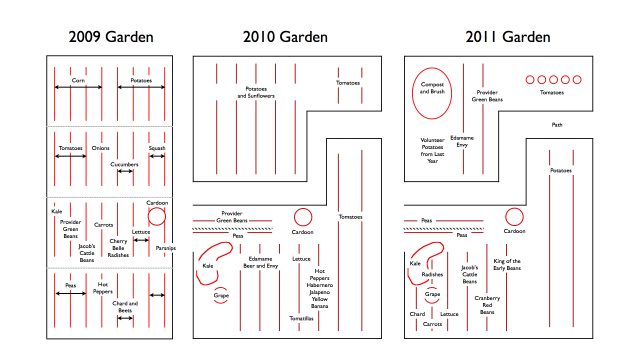 By 2012, cardoon plants were springing up around the main plant; the kale was growing every which way; and an asparagus stalk appeared, unbidden, in the middle of the garden. The northeast edge of the garden was so shaded by the maple tree that it was not suitable for any of my planned vegetables and became a messy repository of twigs, branches and compost.
By 2012, cardoon plants were springing up around the main plant; the kale was growing every which way; and an asparagus stalk appeared, unbidden, in the middle of the garden. The northeast edge of the garden was so shaded by the maple tree that it was not suitable for any of my planned vegetables and became a messy repository of twigs, branches and compost.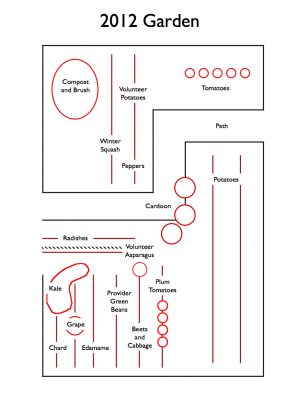 To be honest, I was becoming a bit bored by the orderly rows. And then I read about the edible forest garden. I was intrigued by photos of such gardens with their varied vegetation at different heights. These gardens were not planted in nice neat rows. They also were not traditional annual vegetable gardens. I still wanted an annual vegetable garden, but I wondered if I could create the garden with more visual interest. So I threw all orderly plans to the wind, pulled out scraps of wood and began playing.
To be honest, I was becoming a bit bored by the orderly rows. And then I read about the edible forest garden. I was intrigued by photos of such gardens with their varied vegetation at different heights. These gardens were not planted in nice neat rows. They also were not traditional annual vegetable gardens. I still wanted an annual vegetable garden, but I wondered if I could create the garden with more visual interest. So I threw all orderly plans to the wind, pulled out scraps of wood and began playing.
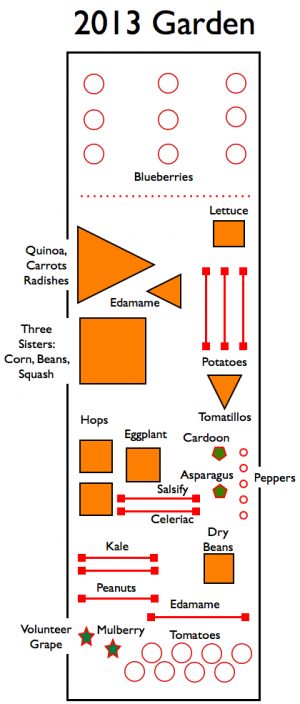 For two Saturdays, I worked in the garden, laying out little beds of different shapes here and there, and dropping down some raised beds wherever I wanted. It felt more like play than like work. I had fun staking an area in some interesting shape, stepping back, contemplating, then rearranging, and then repeating the entire process.
For two Saturdays, I worked in the garden, laying out little beds of different shapes here and there, and dropping down some raised beds wherever I wanted. It felt more like play than like work. I had fun staking an area in some interesting shape, stepping back, contemplating, then rearranging, and then repeating the entire process.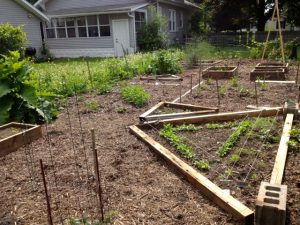
And so my garden area evolves. And, while I do admire the pristine look of an English garden, apparently my natural tendency is toward a more haphazard look.
For now, I am done. And not even I know what next year’s garden will look like.
A Different Kind of Urban Homesteader
When I first moved to Albuquerque, I had a bit of an identity crisis. For so long I had embraced the persona of an urban homesteader. My garden got bigger and bigger and my pantry room shelves were full of jars of canned goods from the garden.
But now I found myself really living in a city, in an apartment with no yard in which to garden and no basement pantry. I had no compost pile for kitchen scraps. There were no solar panels up on my roof. I started to wonder who I was.
I still wanted to grow some of my own food. Actually, I needed to grow my own 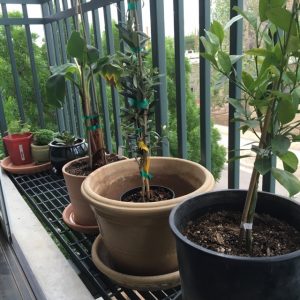 food. One of the first purchases I made last year were tropical fruit trees from Raintree Nursery: an arbequina olive, a calamondin citrus, and a banana. That summer, I added a fig that I bought at the farmer’s market, a couple of basil plants, and a (non–edible) jade plant.
food. One of the first purchases I made last year were tropical fruit trees from Raintree Nursery: an arbequina olive, a calamondin citrus, and a banana. That summer, I added a fig that I bought at the farmer’s market, a couple of basil plants, and a (non–edible) jade plant.
I had quite a menagerie of plants out on our balcony.
In addition, I signed up for a row in the community garden, planted kale, carrots, beans, and lettuce from seed. I bought some tomato and pepper plants, and, in defiance of the community garden rules, planted perennial vegetables such as artichoke, sorrel, perennial arugula, and cutting celery. I even got a beehive which I put at the end of my row in the garden.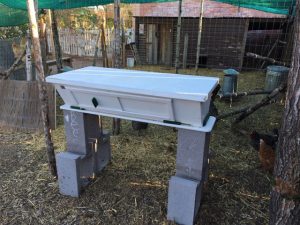
I discovered, much to my delight, that the courtyard at the Old Albuquerque High Lofts had peach and apple trees which no one was harvesting. So I rescued all the peaches from the birds and filled the freezer portion of my refrigerator with frozen peaches.
This year I’m finding that I’m dreaming of having raspberry and blueberry bushes in containers on the balcony. Now I’m wondering if I can grow a pomegranate in a container as well.
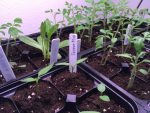 And I’m back to starting tomatoes and peppers from seed. I bought a grow lamp, heating mat, and a dome. Most of my starts have germinated and those little plants (tomatoes, peppers, and my beloved cardoon) are growing quite nicely.
And I’m back to starting tomatoes and peppers from seed. I bought a grow lamp, heating mat, and a dome. Most of my starts have germinated and those little plants (tomatoes, peppers, and my beloved cardoon) are growing quite nicely.
I have little tiny oranges on my citrus plant and my olive tree is covered in flowers.
So, this urban homesteader, even without a homestead, still finds a way to grow food.
A Showcase Plant With a ‘Very Sexy Flavor’
“What is that growing in your garden?” I hear that a lot from people who see my large vegetable garden for the first time. What they are referring to is a huge plant with enormous spiky leaves that looks like a giant, pre-historic thistle.
The plant is cardoon.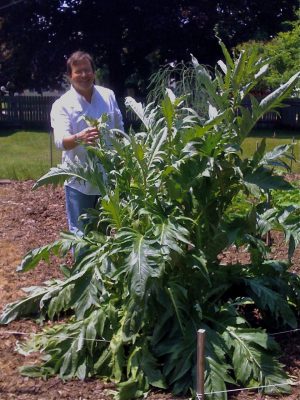 Cardoon is not a common plant in these parts. I purchased a little start from Prairie Trail Farm a few years ago. The name intrigued me. That it was a plant I had never heard of before intrigued me. The description intrigued me. Little did I know that this very small plant in a very small pot would grow to be taller than a person.In seed catalogs, cardoon is described as a Mediterranean herb related to the artichoke. I have always liked artichoke, even as a child. I know that sounds weird; children don’t always like strange vegetables, so I must have been one very strange child. I tried growing artichoke my first two summers here in Goshen with not much success. So when I saw the little plant in the greenhouse and read that it tastes like artichoke, I knew I needed to try it.
Cardoon is not a common plant in these parts. I purchased a little start from Prairie Trail Farm a few years ago. The name intrigued me. That it was a plant I had never heard of before intrigued me. The description intrigued me. Little did I know that this very small plant in a very small pot would grow to be taller than a person.In seed catalogs, cardoon is described as a Mediterranean herb related to the artichoke. I have always liked artichoke, even as a child. I know that sounds weird; children don’t always like strange vegetables, so I must have been one very strange child. I tried growing artichoke my first two summers here in Goshen with not much success. So when I saw the little plant in the greenhouse and read that it tastes like artichoke, I knew I needed to try it.
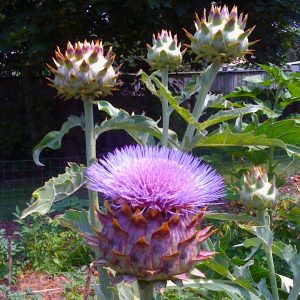 Though the flower buds (which look like little artichokes) are edible, it is the stalks that are cooked and eaten. Cooking cardoon is a somewhat time-consuming process. The stalks can be bitter. In order to diminish that bitter taste, you need to peel the stalks, removing the spines, and cook for at least a half hour with some lemon juice. Once the stalks are prepared, they can be used in a variety of recipes. We’ve made a casserole using cardoon and used it in vegetarian lasagna.
Though the flower buds (which look like little artichokes) are edible, it is the stalks that are cooked and eaten. Cooking cardoon is a somewhat time-consuming process. The stalks can be bitter. In order to diminish that bitter taste, you need to peel the stalks, removing the spines, and cook for at least a half hour with some lemon juice. Once the stalks are prepared, they can be used in a variety of recipes. We’ve made a casserole using cardoon and used it in vegetarian lasagna.
Even though we don’t eat a lot of cardoon, I still love having it in the garden.
It is such a striking plant. And I love that it comes back year after year. Right now, only kale and cardoon are still growing in the vegetable garden, so it is the perfect time to go in search of good recipes for cardoon. I would welcome any suggestions.
If you need an incentive to try growing and cooking cardoon, here is a quote by chef Mario Batali from “The Babbo Cookbook”:
Cardoons are one of my all-time fave vegetables because of their very sexy flavor.
It is not every day that you get to try a vegetable with a sexy flavor. If that intrigues you, I have some cardoon I can give you to try.
Loving the ‘City’ in ‘City Homesteading’
On my profile description, I say that I dream of one day having a five-acre sustainable farm. While that is true, I must admit that I love living in a city.
 I’m a child of the city. I grew up in a suburb that was just across the western border of Chicago. I spent countless hours and days with my family in the city: traveling to downtown on what is now the blue line, shopping in downtown Chicago, seeing the Christmas window displays every year, visiting museums, going to the eye doctor on a school day morning and then having lunch and spending the afternoon at Marshall Field’s with my mum.
I’m a child of the city. I grew up in a suburb that was just across the western border of Chicago. I spent countless hours and days with my family in the city: traveling to downtown on what is now the blue line, shopping in downtown Chicago, seeing the Christmas window displays every year, visiting museums, going to the eye doctor on a school day morning and then having lunch and spending the afternoon at Marshall Field’s with my mum.
After college, I studied in New York City for a year, living on the Upper West Side of Manhattan. I loved the ceaseless activity in my neighborhood, including the fruit and vegetable open–air markets that were selling produce all day and all night. I loved walking from the Upper West Side to the Lower East Side on a Sunday to visit all the vendors that were selling their wares.
I loved being able to travel by bus or by subway just about anywhere that I wanted to go. I snacked on typical New-York-style thin-crust pizza while walking down the sidewalk and bought hot roasted chestnuts from street carts on cold winter days.
Then I moved to Evanston, just north of Chicago, and rediscovered Chicago as an adult, going to places that I had never been to before. My first job after graduate school was in downtown Chicago, working at an options trading company. Every lunch hour, I would quickly eat my lunch and then go outside for a walk in the Lower Loop to window shop and people watch. I loved being able to easily live without a car; I commuted to work by train (the “L”) and walked to neighborhood grocery stores.
My next job took me to Seattle, where, once again I lived in an apartment in the city. Again, everything was relatively close or easy to get to using public transportation. Work was about three miles away, but I had a lot of options for how to get there: usually I rode my bicycle, sometimes I walked, and, if I was feeling tired, I could take a bus. There was a grocery store just a few blocks away that Pete and I always walked to, packing our groceries in the shopping cart I purchased in New York City. Downtown Seattle and Pike Place Market were just down the hill from where we lived, a little over a mile away.
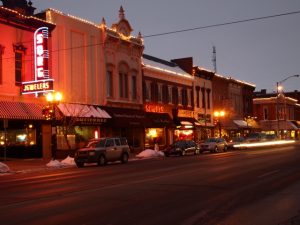 In 1998, we moved from Seattle to the “city” of Goshen. I must admit, after living in large cities, Goshen seemed more like a small town to me, rather than a city. We looked at houses and property out in the country, but ultimately chose to live in town. The main reason for choosing to live in town had to to with reducing our carbon footprint. After living in cities where I either did not have a car, or chose not to use a car for daily activities, I had no desire to live someplace where I had to drive to work.
In 1998, we moved from Seattle to the “city” of Goshen. I must admit, after living in large cities, Goshen seemed more like a small town to me, rather than a city. We looked at houses and property out in the country, but ultimately chose to live in town. The main reason for choosing to live in town had to to with reducing our carbon footprint. After living in cities where I either did not have a car, or chose not to use a car for daily activities, I had no desire to live someplace where I had to drive to work.
And I have no regrets about choosing to live in the city. I can walk, or ride my bicycle, to work, to church, to the library, to downtown, where I can go shopping, for clothes, shoes, hardware, books, groceries, bread and fresh produce. Downtown also has many places where I can gather with friends, over a meal, for coffee or ice cream, to play trivia at my favorite bar, to listen to live music. First Fridays brings a hubbub of activity and plenty of opportunities to window shop and people watch.
It is great to live in a city, even a small city like Goshen. I am fortunate to have the conveniences of city living, with almost all my activities within walking distance of my house, and still have a large enough space where I can do some pretty good gardening and grow my own food.
Maybe that five-acre farm will never come to be. It is more likely that I will eventually end up in a large city again. But that’s quite all right. For now I can have the best of both worlds. And that makes me happy.
Do You Miss It?
For a wonderful two and a half years I lived the life of a farmer and urban homesteader. It was a great experience – not always easy – but something I thoroughly enjoyed.
And then, quite unexpectedly, life took a different and maybe unexpected turn. Now, in a new location, I’m back to teaching college math. Maybe it wasn’t quite so unexpected – I see that my last paragraph in that post from 2014 included the following: “Will I ever teach again? Maybe. I am not ruling it out.”
Do you miss it? Now the question can be applied to my life as a farmer and my life as an urban homesteader.
The answer is still the same: “I prefer looking ahead and at what could yet be.”
to miss (verb)
to discover or feel the absence of

It was about a year ago that I drafted my resignation letter from Goshen College. I was resigning to homestead in the city, to explore small-scale farming, to apprentice at a local produce farm, to start on a different career and see where that would lead me.
Every so often, I get asked the question: “Do you miss it?” I honestly answer, “No,” but I always feel that I need to explain that answer. After all, I was a teacher. It is a profession that many would characterize as a vocation or a calling. We teachers are to be committed to our students, our colleagues, our discipline, the institutions at which we teach. It was hard not to feel a little bit of guilt for having left all that. I was supposed to be a role model and a mentor – a female Ph.D. mathematician in a field still dominated by men. So then, to say that I don’t miss it seems a bit harsh and I feel that I should somehow soften that statement.
I don’t like to use the word “miss.” By definition, “to miss” means “to feel the absence of.” For me, the word “miss” carries with it a sense of regret. If I feel the absence of something, I am looking back at what once was, perhaps dwelling on what could have been. I prefer looking ahead and at what could yet be. That does not mean that I don’t remember (and remember fondly) what was, but I don’t view the past as an absence in my life, as a hole to be filled.
In 1989, Pete and I moved from Evanston, Ill., to Seattle. As we were moving, we were reminded of the 1985 film “The Trip to Bountiful,” where an elderly woman longed to go back to what she still considered her “home” in Bountiful, Texas. She managed to get back there, only to find a deserted, desolate place. It seemed sad – she couldn’t embrace her new home because she was always longing for her old home. She was missing Bountiful, acutely feeling its absence, but Bountiful was no more. We liked living in Evanston, close to Lake Michigan and the parks and beaches, just a short “L” ride to downtown Chicago and the shopping, restaurants and people–watching of a big city. But we were moving to a new city and we didn’t want to keep looking back. So, to mark our new start, we named our Seattle apartment “Bountiful,” to remind us to consider our new location as our new true home, our own “Bountiful.”
When we moved from Seattle to Goshen, our friends in Seattle encouraged us to keep our house, to rent it out, but not sell it, so that we would have a place to come back to. But if we would have done that, would we have been holding on to the past and not looking forward to the future? If we kept our house on Vashon Island, would we ever truly embrace our new home in Goshen? After considering these questions, instead of hanging on to what was, we sold the house that we built and embraced our move as a new adventure. When we were asked why we ever left Seattle to come to Goshen, we replied that it was our Great Indiana Adventure.
In these transitions, even though I was leaving places and people I loved, I never wanted to use the word “miss.” Likewise, now, in my transition from teaching to homesteading and farming, I do not want to use the word “miss.” I enjoyed teaching mathematics. Sure, there were aspects of teaching that did not thrill me (I never looked forward to grading) but, overall, teaching was a profession I loved and was (I think) pretty good at it.
Two weeks ago I was back in the classroom, a substitute for two class periods in one of my favorite courses at Goshen College. It was great. I loved preparing for class, going over the material again, working out examples, solving those homework problems, answering questions, engaging with the students, having conversations with my former colleagues in Science Hall. I experienced again the joys of the academic life.
There were many joys. I have great memories of teaching. Right now, however, instead of dwelling on memories, I am looking forward, wondering where my new experiences will lead me – and building new memories.
Will I ever teach again? Maybe. I am not ruling it out. But do I miss it? No.
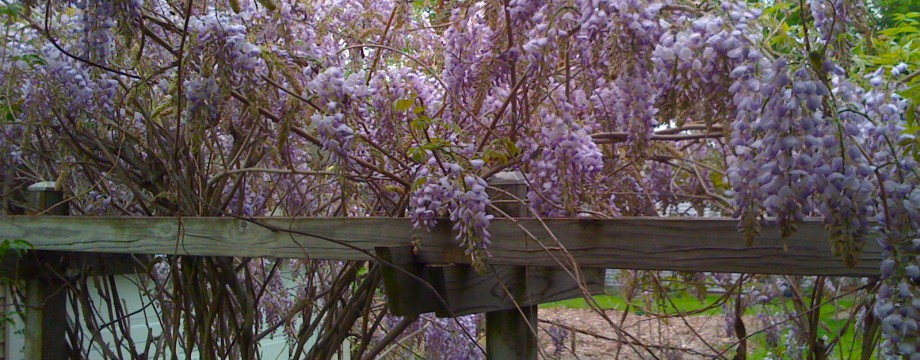
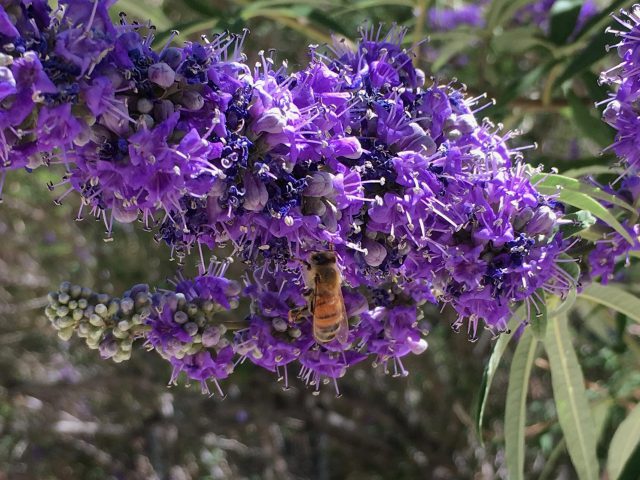
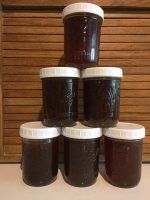
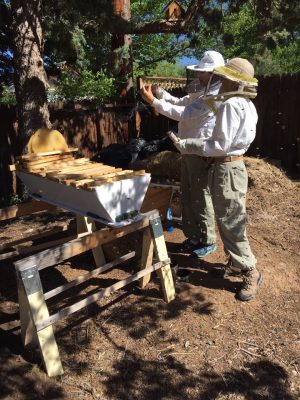
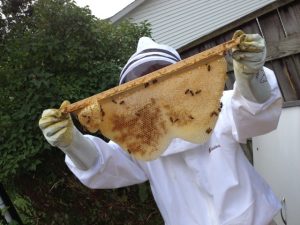
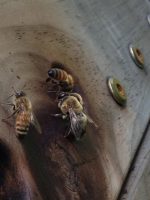
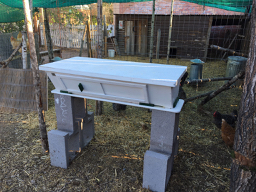
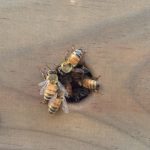
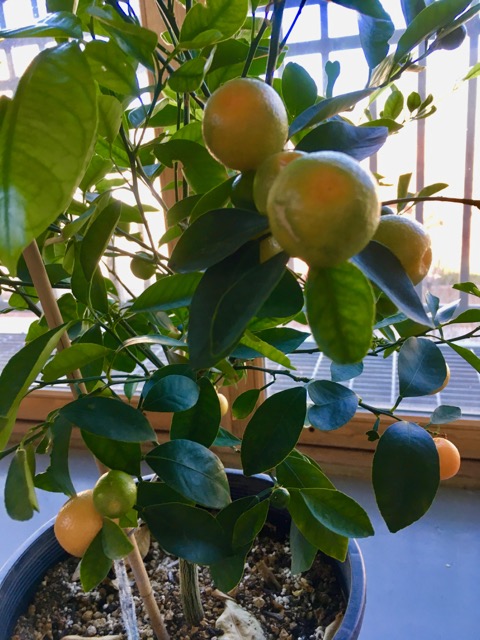
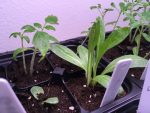 I’m dreaming of having cardoons again – I’m not sure how they will be appreciated in the community garden, but I’ve started some plants from seed and plan on planting them this spring.
I’m dreaming of having cardoons again – I’m not sure how they will be appreciated in the community garden, but I’ve started some plants from seed and plan on planting them this spring.